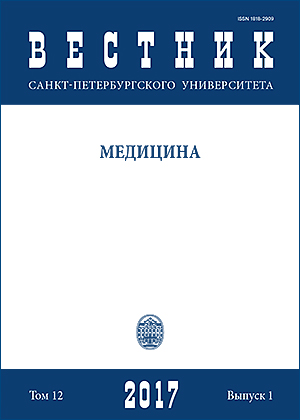МИКРОБИОТА ПОЛОСТИ РТА КАК КЛЮЧ К ПОНИМАНИЮ КАРИОЗНОГО ПРОЦЕССА (СОСТОЯНИЕ ВОПРОСА НА 2016 ГОД)
DOI:
https://doi.org/10.21638/11701/spbu11.2017.105Аннотация
Кариес продолжает оставаться актуальной проблемой современной практической медицины. Учеными предполагается критическая значимость представителей рода Streptococcus при переходе от состояния стоматологического здоровья к состоянию заболевания. Метагеномные исследования микроорганизмов полости рта позволяют изучить роли патогенных видов и функции специфических генов при заболеваниях периодонта и кариесе. Данное направление на стыке дисциплин является одним из наиболее перспективных методов изучения фундаментальных основ патогенеза стоматологической патологии. В данной работе обобщена и представлена информация, опубликованная в научной литературе за 2001–2016 гг. по тематике исследования микробиологических аспектов кариозного процесса. Проанализированы данные электронных научных баз Web of Science, PubMed, Cochrane Library. Библиогр. 19 назв. Ил. 1.
Ключевые слова:
метагеном, биопленки, Streptococcus mutans, кариес
Скачивания
Библиографические ссылки
Р. А. Берне, Д. Дж. Лебланк. М., 2010. С. 86–87.
References
protocols. J. Calif. Dent. Assoc., 2011, vol. 39, no. 10, pp. 723–733.
Evaluation of genotypic diversity of Streptococcus mutans using distinct arbitrary primers. J. Appl. Oral Sci.,2008, vol. 16, pp. 403–407.
of mutacins and mutacin-like gene in Streptococcus mutans. Microbiol. Lett., 2006, vol. 265, no. 11, p. 17.
bonding to dentin and experimental strategies to prevent bond degradation. J. Dent. Res., 2011, vol. 90,no. 8, pp. 953–968.
Загрузки
Опубликован
Как цитировать
Выпуск
Раздел
Лицензия
Статьи журнала «Вестник Санкт-Петербургского университета. Медицина» находятся в открытом доступе и распространяются в соответствии с условиями Лицензионного Договора с Санкт-Петербургским государственным университетом, который бесплатно предоставляет авторам неограниченное распространение и самостоятельное архивирование.




